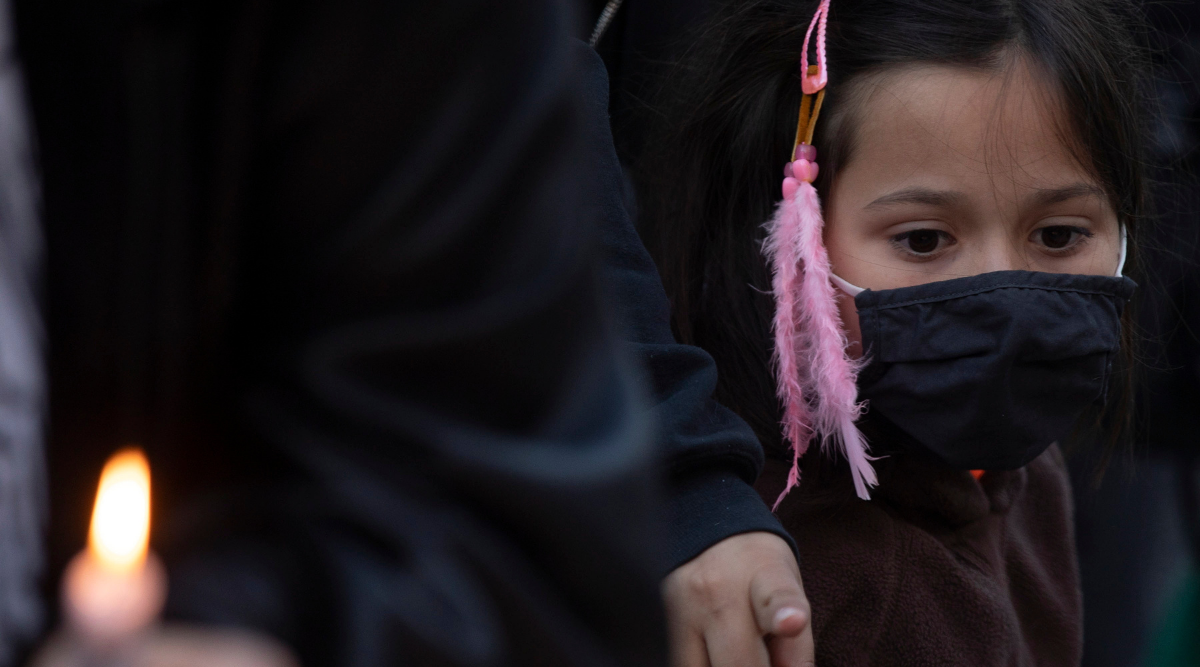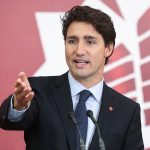An estimated 150,000 Indigenous children passed through the schools between their opening, around 1883, and their closing in 1996
By: New York Times, June 8, 2021  A young girl attends a vigil in Toronto on Sunday May 30, 2021, for the 215 Indigenous children, whose remains were uncovered on the grounds of a former residential school near Kamloops, British Columbia. (AP)
A young girl attends a vigil in Toronto on Sunday May 30, 2021, for the 215 Indigenous children, whose remains were uncovered on the grounds of a former residential school near Kamloops, British Columbia. (AP)
Written by Ian Austen
The announcement last month that the remains of 215 Indigenous children had been found on the grounds of the Kamloops Indian Residential School left the nation reeling.
Flags throughout Canada were put at half-staff and impromptu memorials consisting of children’s moccasins or shoes, often marked with “215,” have sprouted, including one in front of Canada’s Parliament building here.
“A lot of survivors, my relatives, they’ve been saying this for years and years — that there was a lot of death, there’s a lot of unmarked graves,” said Perry Bellegarde, national chief of the Assembly of First Nations, the country’s largest Indigenous organization, referring to children who were taken from their families and forced to attend Canada’s notorious residential schools such as Kamloops to assimilate into Western culture.
“But nobody ever believed the survivors,” he added. “And now with the discovery of the grave site at Kamloops, it’s just horrific, it’s tragic and it’s painful.”
An estimated 150,000 Indigenous children passed through the schools between their opening, around 1883, and their closing in 1996. Since taking office in 2015, Prime Minister Justin Trudeau has prioritized putting in place a list of 94 actions for commemorating the students and improving the lives of Indigenous people. But Indigenous leaders believe the government still has a long way to go.
The discovery of the graves has given new impetus to the nation’s debate on how to atone for its history of exploiting Indigenous people. Many are asking how so many children could have wound up in that burial space.
What has been discovered?
About 20 years ago, an effort to find remains started at the Kamloops school, which operated from 1890 until the late 1970s, and was once Canada’s largest, with 500 students at its peak. Members of the Tk’emlups te Secwepemc First Nation made last month’s grim discovery after bringing in ground-penetrating radar.
Among the 215 bodies found by the radar, there appears to be one of a child who died as young as 3, said Chief Rosanne Casimir of the Tk’emlups te Secwepemc. All of the children were buried decades ago, she said.
Casimir also said she anticipated that more remains would be discovered as the ground is scanned further this month. The community is now working with the Royal Canadian Mounted Police and the coroner’s service in British Columbia.
On Friday, Casimir said the bodies found so far appeared to be buried in separate “unmarked burial sites that are, to our knowledge, also undocumented.”
What was the residential school system?
In the late 19th century, Canada set aside land for Indigenous people through often dubious treaties, while outright seizing Indigenous land in some places, particularly in British Columbia.
Around 1883, the government added a new dimension to its exploitation of Indigenous people. Indigenous children in many parts of Canada were forced to attend residential schools, often far from their communities. Most were operated by churches, and all of them banned the use of Indigenous languages and Indigenous cultural practices, often through violence. Disease and sexual, physical and emotional abuse were widespread.
The Kamloops school was operated by the Roman Catholic Church until 1969, when the federal government took over the school system. Reports by an inspector and a doctor indicated that the students at Kamloops were severely malnourished at times.
A National Truth and Reconciliation Commission set up by the Canadian government spent six years hearing from 6,750 witnesses to document the history of the schools. In a report in 2015, it concluded that the system was a form of “cultural genocide.”
The commission also called for an apology from the pope for the Roman Catholic Church’s role. On Sunday, Pope Francis stopped short of offering a formal apology, but he said that “the sad discovery further raises awareness of the pains and sufferings of the past.”
Some former students testified before the commission that priests at the schools had fathered infants with Indigenous students and that the babies had been taken away from their young mothers and killed, in some cases their bodies thrown into furnaces.
Many students also died from disease, accidents, fires and fatal attempts to escape, according to the commission.
Schools suffered mass deaths when infectious diseases swept through them, according to a report this year on the burial sites by Scott Hamilton, a professor of anthropology at Lakehead University in Thunder Bay.
How many children died at the residential schools?
When children died at residential schools, their families were often given vague explanations or told that they had simply run away and vanished, the commission found. When the schools acknowledged the deaths of children, they generally refused, until the 1960s, to return their bodies to their families. Remains were sent back only if it was cheaper than burying them at the schools.
In its report, the commission estimated that at least 4,100 students had died or gone missing from the residential schools, and it demanded that the government account for all of those children. It did not, however, definitely say how many had disappeared.
Murray Sinclair, a former judge and senator who headed the commission, said in an email last week that he now believed the number was “well beyond 10,000.”
Since the commission ended, a federal project has been underway to document the fates of the children who never returned to their families after being sent to residential schools and now are generally known as “the missing children.”
Remains in unmarked graves have appeared or been discovered through construction or natural events at the sites of other former schools, although nothing on the scale of Kamloops.
Kisha Supernant, an Indigenous woman who directs the Institute for Prairie and Indigenous Archaeology at the University of Alberta, has been leading teams that use ground-penetrating radar and other technologies to hunt for remains.
Hamilton said that simply locating burial sites was often difficult because of poor record-keeping, lost records and the relocation of some schools.
“These graveyards are often now unmarked,” he said. “What they were like 50 or 60 years ago is anyone’s guess. The challenge here is that they have not been maintained. Once the schools were closed, the properties were often abandoned.”
What happens next?
During a special debate in the House of Commons on June 1, Trudeau said Canada had failed the 215 children whose remains were discovered as well as the other children who never returned to their communities from the residential schools.
“Today, some of the children found in Kamloops, and who have yet to be found in other places across the country, would have been grandparents or great-grandparents,” he said. “They are not, and that is the fault of Canada.”
Trudeau said the government heeded calls from Indigenous leaders for money and other help to use radar and various technologies to search for the remains of students at other schools. In 2019, it budgeted 27 million Canadian dollars ($22.35 million) to look for graves. But the money was not distributed.
Bellegarde said he hoped the shock that followed the discovery in Kamloops would lead Canada to accelerate efforts at bringing about reconciliation and eliminating discrimination and the wide economic gap between Indigenous people and the rest of the country.
“We have to use this as this catalyst,” he said. “We’ve helped build this great country and nobody’s going anywhere. We have to work together, so let’s roll up our sleeves and get this work done.”




